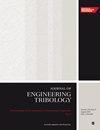考虑刹车片动态磨损的高速重载制动界面摩擦学行为分析
IF 1.8
3区 工程技术
Q3 ENGINEERING, MECHANICAL
Proceedings of the Institution of Mechanical Engineers, Part J: Journal of Engineering Tribology
Pub Date : 2023-08-01
DOI:10.1177/13506501231191852
引用次数: 0
摘要
以兆瓦级风力发电盘式制动器为例,分析了制动盘制动界面动态磨损对接触状态、温度场和压力分布等摩擦学行为的影响及其作用机理。利用任意拉格朗日-欧拉(ALE)技术,通过UMESHMOTION子程序将Archard磨损模型纳入ABAQUS制动界面摩擦学问题的求解中。在不改变其他有限元分析变量的情况下,改变磨损界面网格。在惯性制动试验机上进行了磨损试验,验证了刹车片热-应力-磨损耦合模型。基于制动周期摩擦磨损仿真结果,分析了制动盘动态磨损情况下制动界面摩擦学行为的差异。研究表明,制动盘的动态磨损对制动界面的摩擦学行为有显著影响。具体而言,磨损演化改变了制动过程中的接触状态、应力集中面积和温度场分布。因此,由于这些摩擦学行为,刹车片的磨损性能得到了改善。本文章由计算机程序翻译,如有差异,请以英文原文为准。
Analysis of the tribological behavior of the high-speed and heavy-load braking interface with dynamic wear of brake pads
Using a megawatt wind turbine disc brake as a case study, this work analyzes the effects and action mechanism of dynamic wear on the braking interface of the braking pad on tribological behaviors as contact state, temperature field, and pressure distribution. The Archard wear model was incorporated into the solution of the tribological problem of the braking interface in ABAQUS using the arbitrary Lagrangian–Eulerian (ALE) technique through the UMESHMOTION subroutine. The wear interface meshes were changed without modifying other finite element analysis variables. Moreover, wear testing on the inertia braking tester validated the coupled heat-stress-wear model of the brake pad. The differences in the tribological behaviors of the braking interface with and without the dynamic wear of the braking pad were analyzed based on the simulation results of friction and wear in a braking cycle. The study revealed that the tribological behaviors of the braking interface were significantly affected by the dynamic wear of the braking pad. Specifically, the wear evolution changed the contact state, the area of stress concentration, and the temperature field distribution during the braking process. Hence, the wear properties of the brake pad were modified as a result of these tribological behaviors.
求助全文
通过发布文献求助,成功后即可免费获取论文全文。
去求助
来源期刊

CiteScore
4.20
自引率
5.00%
发文量
110
审稿时长
6.1 months
期刊介绍:
The Journal of Engineering Tribology publishes high-quality, peer-reviewed papers from academia and industry worldwide on the engineering science associated with tribology and its applications.
"I am proud to say that I have been part of the tribology research community for almost 20 years. That community has always seemed to me to be highly active, progressive, and closely knit. The conferences are well attended and are characterised by a warmth and friendliness that transcends national boundaries. I see Part J as being an important part of that community, giving us an outlet to publish and promote our scholarly activities. I very much look forward to my term of office as editor of your Journal. I hope you will continue to submit papers, help out with reviewing, and most importantly to read and talk about the work you will find there." Professor Rob Dwyer-Joyce, Sheffield University, UK
This journal is a member of the Committee on Publication Ethics (COPE).
 求助内容:
求助内容: 应助结果提醒方式:
应助结果提醒方式:


